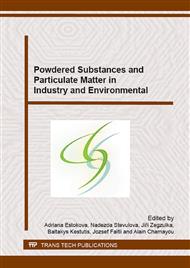[1]
J. Koňařík, Bachelor thesis: The influence of activator on the basic properties of alkali-activated systems, VŠB - Technical University of Ostrava, Faculty of Civil engineering, Department of Building materials and diagnostics of Structures, Ostrava, (2014).
DOI: 10.17512/znb.2017.1.22
Google Scholar
[2]
J. Boháčová, Bachelor theses: Study of influence of various types of an aggregate on properties of geopolymerous systems based on blast furnace slag, VŠB - TUO, 2008, F. Škvára, Alkali-activated materials – geopolymers, Prague, (2007).
Google Scholar
[3]
J. Boháčová, S. Staněk, P. Mec, Preparation and properties of pressed metakaolin and fly ash based alkali-activated binders. Advanced Materials Research, vol. 897 (2014) 65-68.
DOI: 10.4028/www.scientific.net/amr.897.65
Google Scholar
[4]
V. Tomková, Alkali-activated composites based on slags from iron and steel metallurgy, Metallurgy, 48 (2009) 223-227.
Google Scholar
[5]
V. Václavík, J. Daxner, J. Valíček, Utilization of sludge from mine water treatment plant in the segment of thermal insulation mortars, Archives of environmental protection, vol. 40, Issue 1 (2014) 51 – 59.
DOI: 10.2478/aep-2014-0004
Google Scholar
[6]
F. Khestl, J. Boháčová, S. Staněk, Thermal Insulating Alkali-Activated Systems. in: Advanced Materials Research: Durnten-Zurich: 18th Conference of Research Institute for Building Materials Ecology and New Building Materials and Products, ICEBMP 2014, Volume 1000, Zurich, 2014, pp.182-185.
DOI: 10.4028/www.scientific.net/amr.1000.182
Google Scholar
[7]
V. Václavík, T. Dvorský, V. Dirner, Polyurethane foam as aggregate for thermal insulating mortars and lightweight concrete, Tehnicki vjesnik - technical gazette, vol. 19, Issue 3, (2012) 665- 672.
Google Scholar
[8]
V. Václavík, V. Dirner, T. Dvorský, The use of blast furnace slag, Metalurgija, vol. 51 Issue: 4 (2012) 461-464.
Google Scholar
[9]
F. Škvára, Alkali-activated materials – geopolymers, Prague, (2007).
Google Scholar
[10]
J. Davidovits, Inorganic polymeric new materials, Journal of Thermal Analysis. vol. 37, (1991) 1633-1656.
Google Scholar
[11]
J. Davidovits, Geopolymer, Chemistry and application, Institut Geopolymére, (2008).
Google Scholar
[12]
C. Shi, P.V. Krivenko, D. Roy, Alkali-activated cements and concretes, Taylor&Francis, Oxford, (2006).
DOI: 10.4324/9780203390672
Google Scholar
[13]
C. Li, H. Sun, L. Li, A review: The comparison between alkali-activated slag (Ca+Si) and metakaolin (Si+Al) cements, Cement and Concrete Research, 40, 2010, pp.1341-1349.
DOI: 10.1016/j.cemconres.2010.03.020
Google Scholar
[14]
J. Vlček, Material use of slags of ferrous and steel metallurgy by the alkaline activation, Habilitation work, VŠB-TU Ostrava, FMMI, Ostrava, (2008).
Google Scholar
[15]
ČSN EN 196-1 Methods of testing cement - Part 1: Determination of strength. Czech normalization institute, (2005).
Google Scholar
[16]
ČSN 73 1322 Determination of frost resistance of concrete. Czech normalization institute, (1968).
Google Scholar


